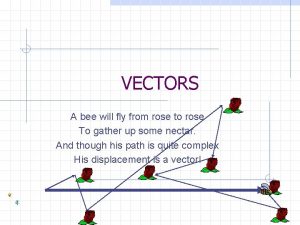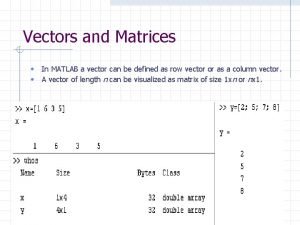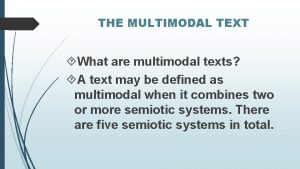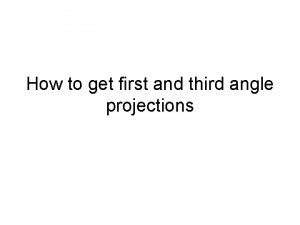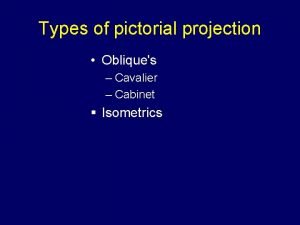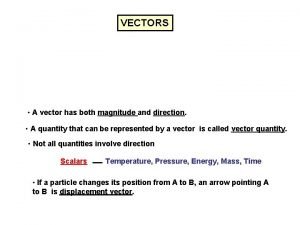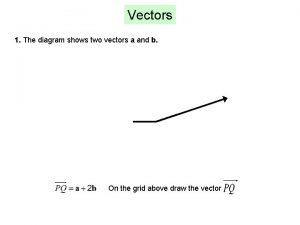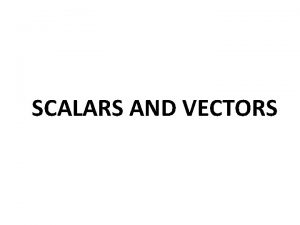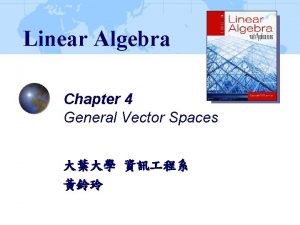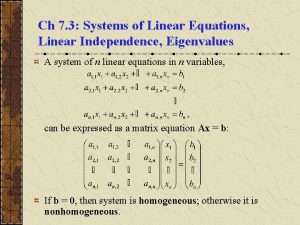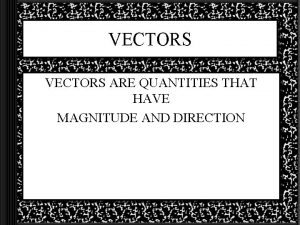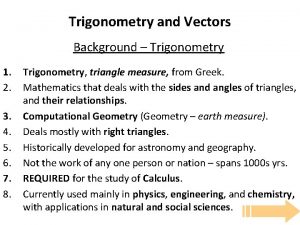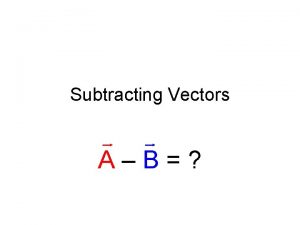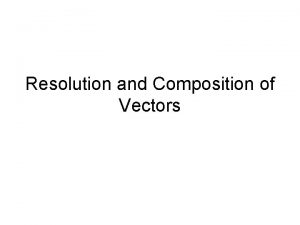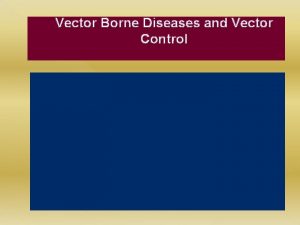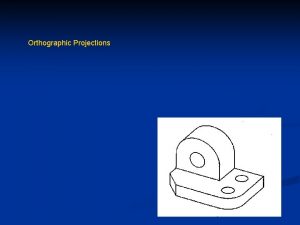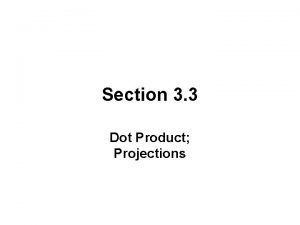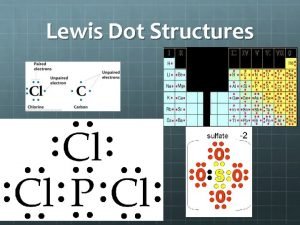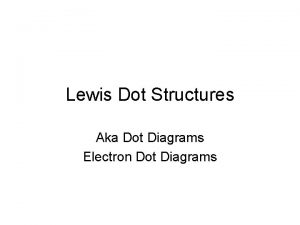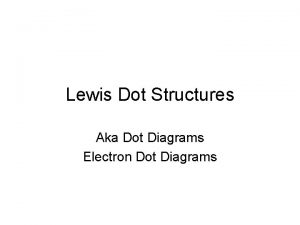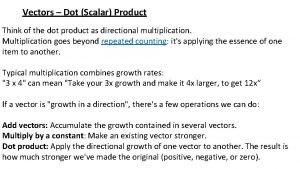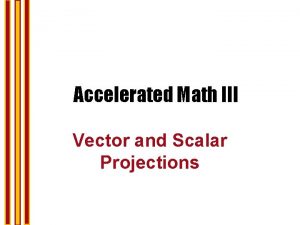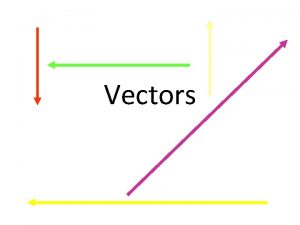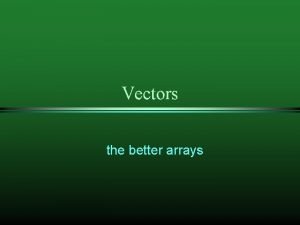Vectors 2 3 Dot Products and Vector Projections








































- Slides: 40

Vectors 2 – 3 Dot Products and Vector Projections

Then & Now: Then: Now: Found magnitudes of and operated with algebraic vectors. 1. Find the dot product of two vectors. 2. Find the projection of one vector onto another.

Dot product of Vectors in a Plane

Example 1: Find the dot product of u and v. Then determine if u and v are orthogonal. u = < 3 , 6 > and v = < - 4, 2 >

Example 1: Find the dot product of u and v. Then determine if u and v are orthogonal. u = < 3 , 6 > and v = < - 4, 2 >

Example 1: Find the dot product of u and v. Then determine if u and v are orthogonal. u = < 3 , 6 > and v = < - 4, 2 >

Example 1: Find the dot product of u and v. Then determine if u and v are orthogonal. u = < 3 , 6 > and v = < - 4, 2 >

Example 1: Find the dot product of u and v. Then determine if u and v are orthogonal. u = < 3 , 6 > and v = < - 4, 2 >

Example 2: Find the dot product of u and v. Then determine if u and v are orthogonal. u = < 2 , 5 > and v = < 8, 4 >

Example 2: Find the dot product of u and v. Then determine if u and v are orthogonal. u = < 2 , 5 > and v = < 8, 4 >

Example 3: Find the dot product of u and v. Then determine if u and v are orthogonal. u = < 3 , - 2> and v = < - 5, 1 >

Example 3: Find the dot product of u and v. Then determine if u and v are orthogonal. u = < 3 , - 2> and v = < - 5, 1 >

Example 4: Find the dot product of u and v. Then determine if u and v are orthogonal. u = < - 2 , - 3 > and v = < 9, - 6 >

Example 4: Find the dot product of u and v. Then determine if u and v are orthogonal. u = < - 2 , - 3 > and v = < 9, - 6 >

Properties of the Dot Product Commutative Property Distributive Property Scalar Multiplication Property Zero Vector Dot Product Property Dot Product and Vector Magnitude Relationship

Example 5: Use the dot product to find the magnitude of a = < - 5, 12 >.

Example 5: Use the dot product to find the magnitude of a = < - 5, 12 >.

Example 5: Use the dot product to find the magnitude of a = < - 5, 12 >.

Example 5: Use the dot product to find the magnitude of a = < - 5, 12 >.

Example 5: Use the dot product to find the magnitude of a = < - 5, 12 >.

Example 5: Use the dot product to find the magnitude of a = < - 5, 12 >.

Example 6: Use the dot product to find the magnitude of a = < 12, 16 >.

Example 6: Use the dot product to find the magnitude of a = < 12, 16 >.

Example 7: Use the dot product to find the magnitude of a = < - 1, - 7 >.

Example 7: Use the dot product to find the magnitude of a = < - 1, - 7 >.

Vector Projection

Example 8: Find the vector projection of u = < 3, 2 > onto v = < 5, - 5 >.

Example 8: Find the vector projection of u = < 3, 2 > onto v = < 5, - 5 >.

Example 8: Find the vector projection of u = < 3, 2 > onto v = < 5, - 5 >.

Example 8: Find the vector projection of u = < 3, 2 > onto v = < 5, - 5 >.

Example 8: Find the vector projection of u = < 3, 2 > onto v = < 5, - 5 >.

Example 8: Find the vector projection of u = < 3, 2 > onto v = < 5, - 5 >.

Example 8: Find the vector projection of u = < 3, 2 > onto v = < 5, - 5 >.

Example 8: Find the vector projection of u = < 3, 2 > onto v = < 5, - 5 >.

Example 9: Find the vector projection of u = < 1, 2 > onto v = < 8, 5 >.

Example 9: Find the vector projection of u = < 1, 2 > onto v = < 8, 5 >.

Example 10: Find the vector projection of u = < 4, -3 > onto v = < 2, 6 >.

Example 10: Find the vector projection of u = < 4, -3 > onto v = < 2, 6 >.

Example 11: Find the vector projection of u = < -3, 4 > onto v = < 6, 1 >.

Example 11: Find the vector projection of u = < -3, 4 > onto v = < 6, 1 >.
 8-3 dot products and vector projections answers
8-3 dot products and vector projections answers 8-5 practice dot and cross products of vectors in space
8-5 practice dot and cross products of vectors in space Id root
Id root Scalar and vector projections
Scalar and vector projections Find the scalar and vector projections of b onto a.
Find the scalar and vector projections of b onto a. Dot product
Dot product Vector dot product
Vector dot product Inner product space
Inner product space Matlab vector of vectors
Matlab vector of vectors Initialize vector matlab
Initialize vector matlab Closed dot in graphing inequalities
Closed dot in graphing inequalities Functional products examples
Functional products examples Dot net vs php
Dot net vs php Dot vector
Dot vector Marketing mix of pepsi and coca cola
Marketing mix of pepsi and coca cola Directed line segment vs vector
Directed line segment vs vector Coordenadas cartesianas
Coordenadas cartesianas How is vector resolution the opposite of vector addition
How is vector resolution the opposite of vector addition Define position vector
Define position vector What is multimodal text
What is multimodal text Third angle orthographic projection symbol
Third angle orthographic projection symbol Cavalier pictorial definition
Cavalier pictorial definition Principles of isometric projection
Principles of isometric projection A storm system moves 5000 km due east
A storm system moves 5000 km due east What are i and j in vectors
What are i and j in vectors Vector components
Vector components Is a vector has magnitude and direction.
Is a vector has magnitude and direction. The diagram shows two vectors that point west and north
The diagram shows two vectors that point west and north 2d motion equations
2d motion equations Difference between vector and scalar quantity
Difference between vector and scalar quantity Entropy is scalar or vector
Entropy is scalar or vector Span vector
Span vector Linearly dependent and independent vectors
Linearly dependent and independent vectors Vectors and the geometry of space
Vectors and the geometry of space Linear dependency
Linear dependency Vectors form 3
Vectors form 3 Chapter 12 vectors and the geometry of space
Chapter 12 vectors and the geometry of space Properties of vector
Properties of vector Vector trig
Vector trig The diagram shows two vectors that point west and north.
The diagram shows two vectors that point west and north. Composition of vectors
Composition of vectors






